Abstract
This paper presents the results of measuring and calculating the final energy consumption for heating and domestic hot water preparation in six apartments located in pre-war tenement houses in Wroclaw (Poland). The calculations were carried out based on energy models of dwellings calibrated with measurement data. Calculation variants were characterized by seven internal parameters (indoor air temperature, heat transfer coefficient by transmission through the internal partition, internal heat gains, air exchange multiplicity in the dwelling, domestic hot water consumption, and domestic hot water temperature and cold water temperature) and two external parameters (outdoor air temperature and insolation). By comparing calculations with measurements, the energy performance gap (EPG) values associated with each parameter were determined. The presented results indicate how much of the differences could be attributed to weather conditions and how much to other factors. It is quite common for the influence of some factors to cancel out the influence of others. Identifying and understanding the real causes of the energy gap may allow for the proposal of better retrofitting solutions or appropriate financial support to households at risk of energy poverty. It is important to note that only in-depth interviews with residents and measurements, such as those carried out in this case, allow such situations to be identified in detail.
1. Introduction
The building sector currently accounts for 40% of total energy demand and 36% of greenhouse gas emissions [1]. This demand is mainly due to the construction, use, renovation, and demolition of buildings. It is estimated that operational energy accounts for about 80% of this demand, and as a result, most effort is currently directed towards improving the energy efficiency of buildings and reducing the energy demand for heating and hot water preparation [2]. Currently, about 75% of the European Union (EU) building stock is energy inefficient and contributes to huge energy losses [1]. Therefore, the objective of the EU sustainable economy is primarily to reduce energy demand and renovate existing buildings and use modern and energy-efficient solutions and materials [1,3]. All these efforts have significantly increased the global emphasis on building energy analysis. The occupants of buildings play a key role in the final energy demand, and simulations related to this impact are a complex and difficult issue. Current research is investigating the impact of users on energy and water consumption and effective methods to reduce this consumption. It has been shown that in order to achieve the goals of reducing occupant energy consumption, a combination of strategies based on recognized sociopsychological theories and the provision of real-time feedback through technology is required [4]. Developments in occupant behavior research are leading to OB (Occupant Behaviors) models and their implementation into control methods for heating, ventilation, and air conditioning (HVAC) systems [5]. These models are still not universal, and their development requires understanding the detailed behavior of specific types of users in buildings with variable characteristics. A recent study presented a process of combining temporal data collected in Google Trends to predict energy consumption in buildings [6]. The search results were shown to be highly correlated with building energy consumption, and the method was identified as feasible for predicting energy consumption. Other studies have shown that the lack of literature on occupant behavior leads to inaccurate simplifications in building modeling and design, so there is a strong need for data on occupant behavior to develop strategies for closing the building energy gap [7]. In addition, the authors emphasized that understanding the various factors influencing occupant behavior should be considered a major consideration in the design and retrofitting of residential buildings. Consequently, predicting energy demand becomes an important element in the design, construction, and efforts to improve the energy intensity of buildings. The increased awareness of climate change and the current geopolitical situation of EU countries causes concerns about the possible increase in the energy poverty problem. The main indicators of energy poverty are low income, high energy cost, inability to pay energy and fuel bills, technical problems related to the dampness of walls, leakages of the building shell and lack of thermal comfort, and inadequate indoor temperature during the winter season [8]. The urgent need to reduce the energy demand of buildings should be addressed by taking into account all factors: improving the thermophysical properties of the building envelope, the climatic characteristics of the location, the availability and efficiency of HVAC systems, and the needs and characteristics of the building users [9]. Attention should also be paid to the performance of the domestic hot water system. It is worth noting three factors that significantly affect the usable energy consumption for hot water preparation, i.e., domestic hot water consumption and the changes in hot and cold water temperatures [10]. Domestic hot water consumption in residential buildings is a random quantity and is characterized by high variability, both during the day and on particular days of the week. It depends on many sociological and technical factors, often difficult to determine [11], such as users’ behavior, attendance, demographic state, furnishing of apartments with sanitary facilities, or ownership of premises. Furthermore, despite the influence of periodical changes in cold water temperature on energy consumption for the preparation of domestic hot water highlighted in the standard [12], it is common to assume a constant cold water temperature value for the calculations, e.g., at 10 °C [13]. On the other hand, the variability of cold water temperature during the year and its strong dependence on outdoor temperature have been emphasized, among others, in publications [14,15]. Ground temperature [16,17,18] or the type of water intake also has a significant influence on this temperature. In the case of hot water, the user decides on the hot water temperature, taking into account national regulations. In Poland, a hot water temperature range from 55 °C to 60 °C is defined in the regulation [19]. In theory, the lower the hot water temperature is, the lower the energy demand for hot water preparation should be. A lower hot water temperature reduces heat losses from the hot water piping system, circulation, or hot water storage system. In reality, however, this lower temperature results in increased hot water consumption.
Energy simulations are the basis for determining the energy demand of a building. However, many studies show large gaps between predicted versus actual building energy demand. In [20], the authors showed discrepancies between measurements and calculations of final energy consumption for heating and hot water preparation. The study clearly observed a relationship between heating sources and heating habits. The results of the research presented in the article [21] confirm that the more complex and varied the user’s heating practices, the more varied and unpredictable their impact on heating energy consumption and comfort, which challenge standard heating profiles. The papers [21,22] highlighted that the causes of the EPG are usually considered in isolation, with most studies focusing on one or two causes separately. This work highlights the need to consider the diversity of possible causes when developing strategies to reduce the EPG. The paper [23] showed that the energy gap problem affects all types of buildings. In addition, the identification and verification of building performance problems are most effective when the developed building energy demand model is based and calibrated on measured data, which allows for the detection of all key problems. Special attention should be paid to the problem of retrofitted pre-war buildings. The article [24] described a gap in occupant comfort that can be arbitrary, as occupants choose to reduce comfort to save money and/or are constrained by the condition of the building and its engineering system. The factors affecting the size of the gap are very often difficult to determine at the energy simulation stage but necessary to meet the challenges of climate change [25,26]. A study in Switzerland used a database of 50,000 buildings and indicated a large range in the size of the EPG of buildings with identical energy ratings [27]. In the cases analyzed, it was not possible to determine exactly what the difference was due to. In addition, it was shown that buildings with low energy ratings tended to consume significantly less energy than expected. Therefore, the reasons and motivations for the energy gap are extremely important issues for modeling energy demand at different scales [28,29]. A multidisciplinary approach is necessary, including sociological, psychological, economic, engineering, and design contexts [30,31]. In the research on parameters affecting the EPG, there is a need to analyze the mentioned factors at the micro level, which mainly include: space layout, location in a block of the building, equipment and sanitary fittings, thermal preferences, and technical and economic opportunities and their impact on the energy behavior of users [30,32]. The authors of a review of the research papers on EPGs emphasized that the causes of EPGs are usually considered separately [22]. They also concluded that most studies focus inaccuracy on building physical modeling, occupant behavior modeling, malfunctioning equipment, and execution of the work. Moreover, the authors highlighted the need to consider the diversity of possible causes when developing strategies to reduce EPGs [22]. The article [33], which analyzed the EPG in a single-family building, also pointed out that the considered causes of the gap can compensate for and hide each other in the simulation results.
As mentioned above, historic residential buildings, in terms of energy efficiency improvements and the considered energy gap, are a separate group covered by specific requirements. Researchers point to the need for extraordinary preventive measures to protect HVAC systems that have historical value. Retrofitting historic buildings is, therefore, an interdisciplinary process in which improving energy efficiency requires the designer to work with a heritage expert [34]. Often this involves many historical, architectural, or functional constraints that make certain measures infeasible. This makes it all the more critical to identify in detail sites with specific energy efficiency requirements. The study results described in this article have identified the factors affecting the EPG in detail. The results will allow for a better understanding of the influence of occupant behavior and external factors on energy consumption in pre-war tenement houses.
2. Materials and Methods
2.1. Aim of the Research
The aim of this study was to analyze in detail the causes of the energy performance gap (EPG) in dwellings in pre-war tenements. The EPG values were analyzed separately for heating and domestic hot water preparation. The presented research extends the work described in the articles [20,31]. Based on the results of the analyses described in those articles, 6 flats with different EPG values were selected from all 15 flats and analyzed for further research work as described in this article. For these dwellings, analyses were carried out to indicate the precise influence of the selected factors on the formation of the energy performance gap. The analyses were performed on the basis of simulations carried out using energy models of flats and calibrated on the basis of measurement data. The method of preparing the models and their assumptions are described in detail in a previous publication [20]. In this paper, the energy consumption modeling process was carried out in more detail, considering, in turn, each of the parameters monitored during the study. It was identified how the following factors affected the value of the energy gap for heating: outdoor air temperatures, temperatures of internal spaces adjacent to the dwelling, internal heat gains, indoor air temperature, and the level of ventilation in the dwelling. With respect to the energy performance gap for water heating, the effects of hot water consumption, cold water temperature, and hot water temperature were identified. The analysis was supported by a detailed description of the situation in the studied premises. The issues described in this paper are of key importance for energy modeling at the micro-scale, for broadening knowledge on energy poverty and its triggers, and for formulating conclusions on fair and sustainable energy management in residential buildings.
2.2. Subject of Study
The analyses were conducted for 6 flats (designated for the purpose of the article as A, B, C, D, E, F) located in pre-war tenement houses in Wrocław (Poland). The entire research, conducted between 14 January and 9 March 2020, included 15 premises. All units are located in the same type of buildings (built before 1920) but were selected for their micro-scale differences. They differed in size, location in the building, heat source, and the situation and lifestyle of the tenants. The premises were selected for detailed research based on a pilot study conducted in 2018 [9] involving 410 residential units. During the detailed study, the indoor air temperature and humidity, CO2 concentration, and detailed consumption of the energy carrier: natural gas, coal, district heat, and electricity (depending on the heating system) were measured. The temperature of the cold water and hot water and the water consumption were also measured. In addition, the outdoor temperature and the temperature of staircases and unheated spaces were measured. Moreover, information was collected on the way the premises were used by the residents, as well as on their preferences and feelings related to the microclimate in the premises, absences, and behaviors, which can have a significant impact on the energy consumption in the premises. A detailed description of the measuring equipment is given in [20]. Simplified floor plans of the 6 residential units analyzed in this paper are shown in Figure 1. Table 1 summarizes the characteristic parameters of the individual flats.
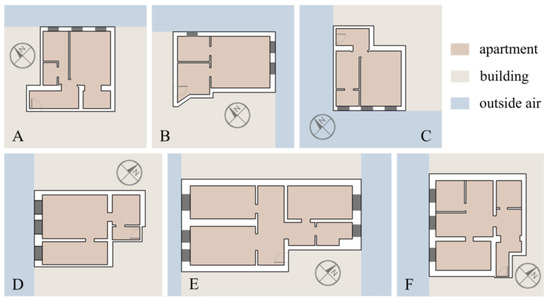
Figure 1.
Floor plans of the residential units: (A–F) symbol of the apartment.

Table 1.
Basic information about the apartments.
2.3. Methodology
For the purposes of the research, two main variants of dwelling use were defined: standard use and actual use. These variants are characterized by seven internal and two external parameters (factors). The internal parameters are indoor air temperature (θi), heat transfer coefficient by transmission through the internal partition (Htr,int), internal heat gains (qint), air exchange multiplicity in the dwelling (n), domestic hot water consumption (VDHW), and domestic hot water temperature (TDHW) and cold water temperature (TCW). The outdoor parameters are outdoor air temperature and insolation. In the first variant (standard use), the parameter values were assumed in accordance with Polish regulations [13,19]. The following interior temperature values in the apartments were assumed: 20 °C in residential rooms and 24 °C in bathrooms. The ventilation level was assumed 1152 m3/h per m2. DHW consumption was assumed at the level of 1.6 L/day per m2. A summary of the standard internal parameter values for the individual dwellings is shown in Table 2. The second variant (actual use) assumes parameter values in accordance with the measurements carried out during the research (in the period from 14 January to 9 March 2020). The values of the internal parameters for individual dwellings are presented in Table 3. These values, for some dwellings, deviate quite considerably from the standard conditions corresponding to the use of the dwellings as prescribed by the regulations [13,19].

Table 2.
Standard use internal parameter values assumed on the basis of [13,19].

Table 3.
Actual use internal parameter values obtained during tests [20].
The calculations for the final energy demand for heating and domestic hot water preparation were carried out for both dwelling use variants. Simulations were carried out based on energy models of dwellings calibrated with measurement data. These models are described in detail in [20]. The discrepancy between actual consumption (Qh,actual, Qw,actual) and calculated consumption (Qh,standard, Qw,standard) is described by the energy performance gap, which is defined by Formula (1) for space heating and Formula (2) for water heating.
Then, in order to examine the impact of individual internal and external parameters on the energy consumption of the dwellings, further simulations were carried out, showing the value of energy demand for heating and domestic hot water for different conditions of use of the dwellings. Table 4 summarizes the analyzed variants for heating. Table 5 summarizes the analyzed variants for the use of the hot water system.

Table 4.
Variants for use of dwellings (heating).

Table 5.
Variants for use of dwellings (domestic hot water).
In this paper, in addition to determining the total EPG for heating and domestic hot water preparation, their components (partial EPG values) were analyzed. For heating, it was determined which part of the total difference between energy consumption in standard and real conditions depends on:
- EDh(1)—the difference between the outdoor air temperature under actual and standard conditions, calculated as:
- EDh(2)—the difference between standard and actual internal heat gains, calculated as:
- EDh(3)—the difference between the standard and actual air temperatures of the indoor spaces surrounding the dwelling unit, calculated as:
- EDh(4)—the difference between the standard and actual conditions of use of the premises (internal air temperature and ventilation), calculated as:
For the domestic hot water system, it was determined how much of the total difference between energy consumption under standard and real conditions depends on:
- EDw(1)—the difference between hot water consumption under actual and standard conditions, calculated as:
- EDw(2)—the difference between the cold water temperature under actual and standard conditions, calculated as:
- EDh(3)—the difference between the hot water temperature under actual and standard conditions, calculated as:
3. Results
3.1. Structure of the Final Energy Consumption in Dwellings
The scope of this study allowed us to assess the structure of final energy consumption for all purposes of premises use. Figure 2 shows that the pattern of final energy consumption varies considerably between premises.
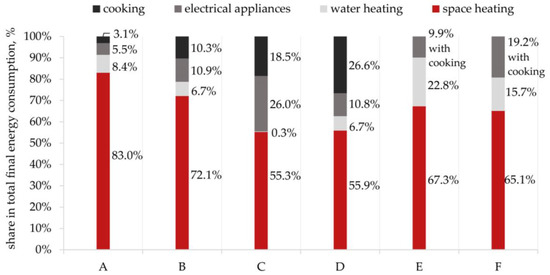
Figure 2.
Structure of final energy consumption in the analyzed dwellings in the study period (from 14 January to 9 March 2020).
During the study period, 3338 kWh (75.2 kWh/m2) of final energy was consumed in dwelling A. Most of it, 83.0%, was for heating the dwelling. Apartment B consumed 1520 kWh (37.3 kWh/m2) of final energy over the same time period. Most of it, 72.1%, was for heating the dwelling. Apartment C consumed 652 kWh (18.9 kWh/m2) of final energy. More than half of this energy, 55.3%, was for heating the dwelling. Apartment D consumed 1554 kWh (35.2 kWh/m2) of final energy. More than half, 55.9%, was for heating the dwelling. Apartment E consumed 2821 kWh (33.1 kWh/m2) of final energy. A significant part of it, 67.3%, was used for heating the dwelling. Apartment F consumed 2220 kWh (39.7 kWh/m2) of final energy. Most of it, 65%, was for heating the dwelling.
The differences between dwellings are not only in the share of heating in total energy needs but also in the value of average unit final energy consumption in dwellings. The variation of this consumption is from 18.9 kWh/m2 for apartment C to 75.2 kWh/m2 for apartment A. It is also worth noting the significant differentiation in the share of energy needs related to the preparation of hot water (from 22.8% for unit E to 0.3% for unit C). The next part of this article discusses this issue and indicates the reasons for such variation.
3.2. Final Energy Use for Space and Water Heating: Energy Performance Gap
A comparison of the results for the measurements and calculations of final energy consumption for heating (Figure 3) in the six analyzed dwellings shows significant variation in the values during the analyzed time period (from 14 January to 9 March 2020). The EPGh values determined according to Equation (1) ranged from +29% for apartment A to −75% for apartment C.
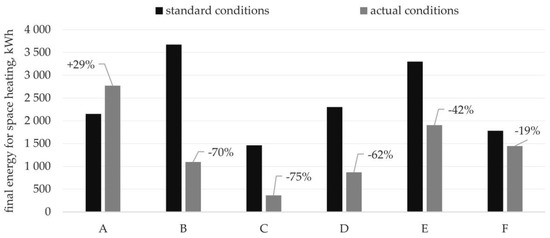
Figure 3.
Actual and standard final energy consumption for space heating for time period from 14 January to 9 March 2020 showing the energy performance gap for space heating (EPGh).
The EPGh value was influenced by many parameters, including outdoor air temperature and insolation, temperature and ventilation efficiency in the dwelling, air temperature in neighboring dwellings, and internal heat gains. Depending on the values taken, some of these factors increased and others decreased the value of the energy gap. The outside air temperature during the study was higher (4.4 °C) than predicted by the standard conditions (−1.1 °C). Insolation during the study period was about 10% higher than for standard conditions. The study coincided with the warmest heating season in Wroclaw in the last 10 years, so the shown reduction in energy consumption of the premises related to the weather factor was close to the maximum that can be expected. It is relatively straightforward to account for a different heating season than the standard heating season in the calculation of energy demand for heating. Universal access to climate data makes it possible to calculate any past heating periods and estimate possible changes in energy demand for heating. It is much more difficult to account for the influence of other factors, as discussed later in this article.
A comparison of the results of the measurements and calculations of energy consumption for hot water preparation (Figure 4) in the six analyzed residential units also shows significant variation in the values during the analyzed period (from 14 January to 9 March 2020). The EPGw values determined according to Equation (2) ranged from +47% for apartment A to −99% for apartment C.
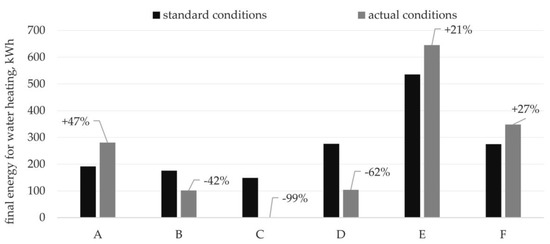
Figure 4.
Actual and standard final energy consumption for DHW (domestic hot water) preparation for time period from 14 January to 9 March 2020 showing the energy performance gap for water heating (EPGw).
The EPGw value was influenced by a number of factors, including medium consumption, hot water temperature, and cold water temperature. Depending on the values taken, some of these factors increased and others decreased the energy gap value. One of the main factors influencing the energy consumption for hot water preparation was its consumption. This information is relatively easy to obtain for an existing dwelling, just like climate data for the simulation of energy demand for heating. However, information about the consumption of hot water without information about its real temperature can be distorting information. It is only the consumption together with the temperature that represents the real energy intensity related to the users’ preferences. This is compounded by the fact that the temperature of the cold water can change as a result of outside air temperature changes. Depending on the water intake [35] and the location of the domestic hot water preparation system in the building (the cold water is heated in the building by transmission), the temperature at the entry to the domestic hot water preparation system can be different than assumed in the standard conditions.
3.3. Final Energy Use for Space and Water Heating for Premises A
Apartment A is heated with one tiled stove located in the living room and permanently installed electric radiators in all rooms. The occupants are two adults (a married couple). The energy demand for heating under standard conditions was 2150 kWh. The actual energy consumption for heating was 2770 kWh (62.3 kWh/m2), which is 29% higher. This result was due to the superposition of several factors (Figure 5). On the one hand, the higher outdoor air temperature, which has a direct impact on energy consumption for heating, justifies the 736 kWh difference, but in the direction of reducing energy intensity. The reason for the increased energy consumption for heating turns out to not only be the condition of the studied dwelling, as shown by a 294 kWh consumption increase as a result of lower-than-expected heat gains in the dwelling, but also the situation related to its environment. The apartment is located in an annex which is in very poor technical condition. The external walls are not insulated, and there is a significant problem with dampness in the walls and basement, where water constantly floods. In addition, many units in the building suffer from energy poverty. This resulted in underheated rooms or no heating at all. The analyzed apartment is surrounded by premises with much lower internal temperatures. Taking into account the very low thermal insulation of the building envelope, this situation causes very high heat losses in this apartment, which are involuntarily used by the neighboring apartments. This results in increased energy consumption for heating by 1311 kWh. The material situation of the inhabitants allows them to maintain relatively comfortable conditions in the apartment. The energy consumption, costs, and emissions differed only slightly from those established for standard conditions. The reduction in energy consumption associated with a different than calculated indoor air temperature and ventilation was only 248 kWh.
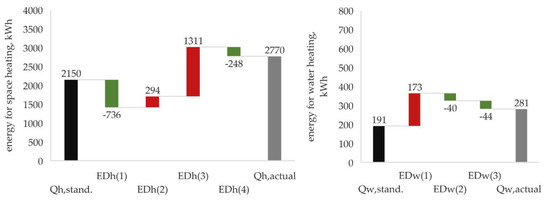
Figure 5.
Influence of individual parameters on the values of energy consumption for heating (Qh) and hot water preparation (Qw) for unit A.
Domestic hot water is prepared in the apartment by means of an electric storage heater located in the bathroom. The actual final energy consumption for hot water preparation was 281 kWh, which is 47% higher than the theoretical consumption of 191 kWh. The reason was a higher consumption of hot water, which resulted in an increase in energy consumption for hot water preparation by 173 kWh. However, the actual energy consumption was affected by two other factors. The cold water supplied to the premises was higher than the theoretical value during the study period. This resulted in a reduction in energy consumption by 40 kWh. The hot water temperature was also different than the calculated temperature. This resulted in a reduction in energy consumption by 44 kWh.
3.4. Final Energy Use for Space and Water Heating for Premises B
Apartment B is a small apartment located in the attic of a tenement house (adjacent to the attic) and is inhabited by a retired woman. The main source of heating is a tiled stove, and when the outside temperature is low, electric heaters in the living room and kitchen are also used. The energy demand for heating under standard conditions was 3671 kWh. The actual energy consumption for heating was 1095 kWh, which is 70% lower. This result was due to the superimposition of several factors (Figure 6). The higher than standard outdoor air temperature was the reason for the 1138 kWh reduction in energy consumption. As a result of lower-than-standard indoor gains, energy consumption increased by 343 kWh. The factor causing the reduction in energy consumption (by 250 kWh) was lower than assumed in the standard variant heat losses to the surrounding rooms. In addition, the significantly lower temperature in the apartment caused a reduction in energy consumption by another 1532 kWh. One of the reasons for the underheating of this apartment was the need to carry coal to the top floor of the building. Maintaining proper thermal comfort in the apartment, in addition to a large amount of physical effort, would require more than double the financial expenditure on heating. The discussed case illustrates the problems of a social group, i.e., pensioners, often living on high floors in premises heated by inefficient heat sources, whose financial situation does not allow them to maintain thermal comfort or to change the heating method to one cheaper and less burdensome in operation.
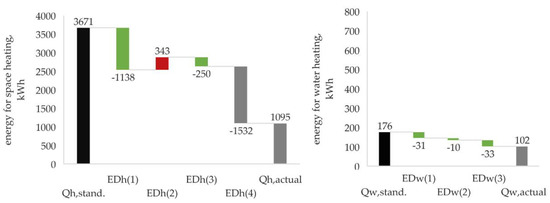
Figure 6.
Influence of individual parameters on the values of energy consumption for heating (Qh) and hot water preparation (Qw) for unit B.
The apartment has no separate bathroom, and all hygienic activities are performed in the kitchen, where a shower and toilet are located behind a thin partition wall. The domestic hot water is prepared by an electric storage heater. The actual final energy consumption for hot water preparation was 102 kWh which is lower than the theoretical value of 176 kWh by 42%. The reason for this is the lower consumption of DHW, which alone resulted in a reduction in energy consumption for DHW preparation by 31 kWh. The actual energy consumption was affected by two other factors. The cold water supplied to the premises was higher than the theoretical value during the study period. This resulted in a reduction in energy consumption by 10 kWh. In addition, the hot water temperature was lower than the calculated temperature. This resulted in a reduction in energy consumption by 33 kWh.
3.5. Final Energy Use for Space and Water Heating for Premises C
Premises C is a small apartment located on the second floor of a four-story building inhabited by a retired couple. The main source of heating is a tiled stove with a built-in electric heater located in the living room. In order to heat the bathroom during bathing, the inhabitants occasionally run a small electric heater. The final energy demand for heating for standard conditions was 1460 kWh. The actual energy consumption of the property was much lower at only 360 kWh, a 75% reduction. The significantly underestimated energy demand was the result of several factors (Figure 7). The first of these, as in the other units, was the higher outside air temperature, which reduced heating needs by 487 kWh. Slightly lower internal gains than anticipated resulted in an increase in heating energy demand of 78 kWh. In addition, slightly higher heat losses to spaces surrounding the premises contributed to the increase in energy needs (by 388 kWh). However, the biggest problem diagnosed in the building was the significantly underestimated indoor temperature and lack of proper ventilation of the premises. The average temperature recorded during the measurements was the lowest of all surveyed premises, at 16.6 °C, and the average concentration of carbon dioxide was approximately 3000 ppm, which is three times the recommended standard. These factors resulted in a reduction in energy demand for heating the premises by 1080 kWh.
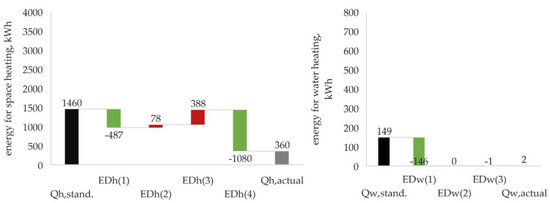
Figure 7.
Influence of individual parameters on the values of energy consumption for heating (Qh) and hot water preparation (Qw) for unit C.
The apartment is equipped with an electric water heater. The theoretical energy demand for hot water preparation under standard conditions was 149 kWh. However, no significant consumption of hot water prepared by the electric heater was registered during the measurements. It is likely that the residents heated the water using a gas stove.
The lack of permanent access to hot water (preparing water in an electric water heater generates costs they are not able to bear) and underheating of the premises (no heating system able to provide the required indoor temperature at an acceptable cost) indicate that the inhabitants of the premises are suffering from energy poverty.
3.6. Final Energy Use for Space and Water Heating for Premises D
Premises D is a medium-sized apartment located on the first floor of a partially thermo-modernized building. The apartment is surrounded on many sides by unheated rooms—a cellar and a staircase. The apartment is occupied by a retired couple. The main source of heating for the apartment is a central heating system fed from the municipal heating network. The apartment has a problem with dampness in the building partitions, which is caused by inadequate ventilation and the underheating of rooms. The energy demand for heating under standard conditions was 2302 kWh. However, the actual energy consumption of the unit was significantly lower (by 62%) and amounted to 869 kWh. This was due to several factors (Figure 8). First, as in the other premises, the higher outdoor temperature resulted in a demand reduction of 760 kWh. The slightly lower internal gains than anticipated increased energy demand by 170 kWh, and heat losses to spaces surrounding the premises increased demand by 57 kWh. However, the biggest problem of the property was the cost of using the central heating system. As this was a significant proportion of residents’ expenses, alternative energy sources were sought. The premises were heated with a gas stove, which contributed to a significant increase in humidity in the premises, and the CO2 concentration exceeded the norm more than twice. The average internal temperature during the study was 18.7 °C, which reduced the energy demand by as much as 899 kWh. Unfortunately, the problem of energy poverty was also noted in this dwelling. The highest unit heat loss coefficient of 7.9 W/K (under standard conditions) among the studied premises made it impossible for the occupants to maintain a comfortable indoor temperature due to energy costs.

Figure 8.
Influence of individual parameters on the values of energy consumption for heating (Qh) and hot water preparation (Qw) for unit D.
The hot water demand at the property for standard conditions was 276 kWh and was higher than the actual consumption by as much as 62%. The main factor affecting the amount of actual energy demand for hot water was the amount of consumption, which was significantly reduced and resulted in a reduction in energy demand of 149 kWh. The low hot water consumption was probably due to the lack of a separate bathroom area, and all hygienic activities were performed by the tenants in a separate part of the kitchen. The cold water temperature was lower than under standard conditions and resulted in an increase in energy demand of only 13 kWh. A slightly lower hot water temperature reduced the demand by 36 kWh.
3.7. Final Energy Use for Space and Water Heating for Premises E
Apartment E has an area exceeding 80 m2, is located on the second floor of a tenement house, and is inhabited by a working couple with a child. The heat source in the apartment is a central heating system supplied by the district heating network. The energy demand of the apartment for standard conditions was 3298 kWh. The actual energy consumption of the apartment was lower by 42% and amounted to 1902 kWh. The total reduction in demand was the result of several factors (Figure 9). The first was the higher outdoor air temperature, which resulted in a reduction in demand by 1154 kWh. The factor that increased demand was the lower internal gains than for standard conditions. This resulted in an increase of 491 kWh. Although the central heating system was relatively new, the apartment was adjacent to a staircase where significant heat losses and a lack of a functioning central heating system were diagnosed. Increased heat losses to the surrounding space resulted in an increase in energy demand for the heating of the apartment by 324 kWh. On the other hand, the largest share in the final energy consumption had a slightly lower internal temperature, which during the measurements averaged 19.1 °C, resulting in a decrease in energy demand for heating by 1057 kWh. It is worth noting that, unlike units B–D, the lower indoor temperature was not a result of necessity but of choice. Residents declared that the reduced indoor temperature in the unit was a result of their preference and they were not in fuel poverty.

Figure 9.
Influence of individual parameters on the values of energy consumption for heating (Qh) and hot water preparation (Qw) for unit E.
The domestic hot water demand at the property was 535 kWh for standard conditions and was 21% lower than the actual demand. The main factor affecting the energy demand for hot water was the increased consumption, which resulted in an increase of 125 kWh. The second factor affecting the increased demand was the slightly lower cold water temperature, which caused an increase of 68 kWh. On the other hand, the lower hot water temperature resulted in a decrease of 83 kWh, resulting in a final energy consumption for hot water of 645 kWh.
3.8. Final Energy Use for Space and Water Heating for Premises F
Apartment F is a property heated by an individual gas boiler, which is a new installation in the apartment. In 2017, the residents undertook an investment to carry out a major refurbishment and change the then coal-fired heating system. The premises are occupied by a family with two children. The energy demand for heating the premises under standard conditions was 1781 kWh. The actual energy consumption during the study was 1445 kWh, which is 19% lower. Several factors contributed to this difference (Figure 10). As in the case of the previous units, the reduction in energy demand was influenced by the higher outdoor air temperature, reducing the energy intensity of the unit by 683 kWh. In contrast, further parameters increased consumption. The lower-than-expected internal gains increased the energy demand by 106 kWh. In addition, the location of the premises in direct contact with the unheated staircase and above the building entrance gate also increased the energy intensity by 141 kWh. The last internal factor affecting the size of the gap was the internal temperature. The average temperature recorded during the study was 21.9 °C. In addition, adequate ventilation was maintained in the apartment, and the average concentration of carbon dioxide during the study was 855 ppm. The increased internal temperature increased the energy demand by 100 kWh; however, this was a conscious and controlled decision by the occupants and was not due to a malfunctioning central heating system. This apartment is an example of maintaining all the necessary thermal comfort requirements.
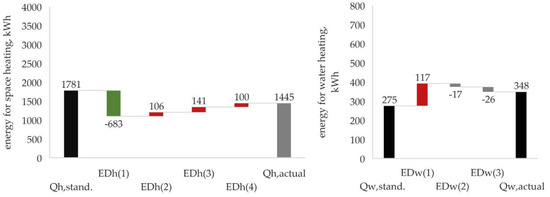
Figure 10.
Influence of individual parameters on the values of energy consumption for heating (Qh) and hot water preparation (Qw) for unit F.
Domestic hot water is also prepared in the apartment by means of a gas boiler. The actual energy consumption for hot water was 348 kWh and was higher than the theoretical energy consumption of 275 kWh by 27%. The difference was mainly influenced by the amount of water consumption, which resulted in an increase in energy demand for hot water of 117 kWh. Other factors, such as cold water temperature and hot water temperature, resulted in a decrease in energy demand by 17 and 26 kWh, respectively.
4. Discussion
The above section describes the detailed results of the measurements and analyses for all six dwellings. The following discussion attempts to compile these results with each other. This summary is in response to publications indicating the need to search for the causes of the energy gap in buildings supported by in situ research [36]. In particular, research in the area of the most energy-problematic buildings [7,37], of which pre-war tenements are representative.
By relating the individual values of the difference in energy consumption between the analysis variants (EDh) to the energy demand for heating under standard conditions (Qh,standard), the energy gap values EPGh associated with each parameter were determined. The values of these partial EPGhs are shown in Figure 11. The conclusions from the comparison of these data are described below.
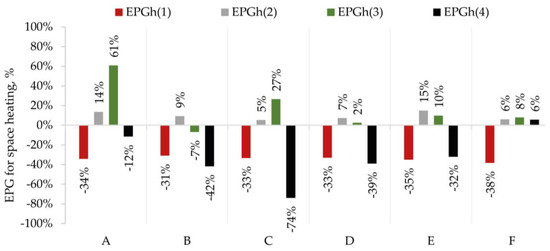
Figure 11.
EPG for space heating for the analyzed parameters: EPGh(1)—outdoor air temperature, EPGh(2)—internal gains, EPGh(3)—influence of zones surrounding the premises, EPGh(4)—internal temperature and ventilation.
- The outdoor air temperature had a similar effect on the energy gap value (EPGh(1)) in all premises. The discrepancies shown are quite high because the period during which the study was conducted was much warmer than the standard period.
- The difference between that assumed for calculations (7.1 W/m2) and the actual internal gains can have a significant impact on the energy gap values. The EPGh(2) values in the studied premises related to this factor were between 5% and 15%. Thus, the real gains were lower in each of the analyzed cases and resulted in an increase in the energy intensity of the facility.
- The influence of the surroundings (understood as the influence of the internal temperature of the areas surrounding the apartment) can be significant. In the investigated apartments, different than assumed temperatures of the rooms surrounding the apartment most often caused an increase in its energy consumption (EPGh(3)) in relation to the standard conditions. In apartment A, the value of EPGh(3) reached 61%. Such a significant impact of the surroundings on the energy consumption for heating the dwelling is typical for pre-war tenements due to the low insulation of the internal partitions. It is common for some of the residents who keep the temperature in their apartments too low to heat themselves at the expense of their neighbors. The common occurrence of vacant or unheated staircases (as exemplified by the tenement houses under study in Wroclaw) additionally caused the actual energy consumption of individual apartments to significantly differ from the calculated energy consumption. In the process of the modernization of such buildings, efforts should be made to detect and minimize such situations, aiming at equitable distribution of building heating costs among individual apartments.
- The temperature conditions in the premises were one of the main factors affecting the energy gap value (EPGh(4)). This parameter interacts with the temperature of the surrounding areas. Low internal temperature intensifies the extraction of thermal energy from the surrounding areas (if they have a higher temperature). Very different situations were observed in the analyzed premises. In dwellings A and F, a temperature close to the typical one was maintained, resulting in a small change in energy consumption with respect to standard conditions. In premises B, D, and E, the temperatures were lower than the standard, and the observed reduction in energy consumption for heating was from 32% to 42%. In apartment B, this effect was exacerbated by the higher temperature of the surrounding rooms. In premises C, a 74% reduction in energy demand was achieved as a result of the extremely low internal temperature and very limited ventilation.
The results described above demonstrate how strongly the environment (external and internal) of the premises and the user’s decisions on how to use it can influence actual energy consumption. Awareness of the level of the possible influence of these factors is essential for those involved in planning the thermo-modernization of buildings or their energy efficiency, as also confirmed by the authors of [38]. The research results presented in this article provide illustrative data but are not yet sufficient to create models describing the user’s influence on a building’s energy efficiency. Further research work, data collection, and studies on the influence of such factors on building thermo-modernization schemes are needed, thus extending the work indicated as relevant by, among others, the authors of [39].
By relating the individual values of the difference in energy consumption for hot water preparation between the analysis variants (EDw) to the energy demand for preparation under standard conditions (Qw,standard), the energy gap values EPGw associated with the parameter were determined. The values of these partial EPGw values are shown in Figure 12. The conclusions of the comparison of these data are described below.
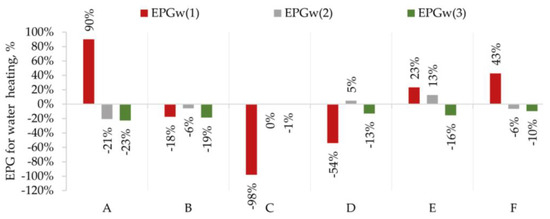
Figure 12.
EPG for water heating for the analyzed parameters: EPGw(1)—hot water consumption, EPGw(2)—cold water temperature, EPGw(3)—hot water temperature.
- Hot water consumption is a key factor influencing the energy consumption for hot water preparation. The values of EPGh(1) in the studied premises related to this factor were from +90% to −98%. The discrepancy between calculations and reality is, therefore, huge. Importantly, it is necessary to consider the revised value of DHW consumption in conjunction with information on the actual temperature of the medium.
- An important factor influencing the actual energy consumption for DHW preparation is the cold water temperature at the heating system inlet. This parameter, which is rarely analyzed in detail, can have quite a significant influence on the result. In premises A, B, and F, this temperature was higher than the assumed 10 °C, which resulted in lower than standard energy consumption. In these premises, individual systems for hot water preparation were installed, and cold water heated up when flowing through the installation inside the building. In dwellings D and E, located in buildings with a central heating system, the situation was the opposite, as a result of the lower-than-expected temperature, the energy consumption increased relative to the standard.
- The last analyzed factor was the temperature of the hot water. In the investigated apartments, the temperature was lower than assumed in the standard variant, which resulted in a decrease in energy consumption for the preparation of domestic hot water from 1% to 23%. The lower temperature of hot water quite often resulted in increased consumption (this was, for example, the case in apartments A, E, and F).
The results described above show that the energy demand for DHW preparation is a value sensitive to external factors. Awareness of this fact is essential for a proper assessment of the efficiency of existing buildings. In order to accurately reflect the energy consumption for this purpose, it is not sufficient to only obtain data on the actual hot water consumption of the building, it is also necessary to model or measure the cold water temperature and obtain information on the hot water temperature settings of the automatic heat source control systems.
It should be noted that an accurate diagnosis of the causes of the energy gap is not possible without accurate measurements of energy consumption and parameters in the building. However, knowing which factors influence the energy gap and to what extent can provide information to support a diagnosis of the energy efficiency of a building. In turn, diagnosing the inadequacies of the building’s use can allow multidimensional solutions to be proposed for the thermo-modernization of pre-war tenements, both in terms of improving the thermal insulation of the building and in terms of guidelines for correct user behavior, such as maintaining an appropriate temperature or taking care of the rational consumption of hot water, or solutions aimed at reducing energy poverty. These issues are among the most important and such topics are addressed in many publications of interest [40]. The development of research in this area is essential for achieving climate neutrality.
5. Conclusions
The presented results show the differences between actual and standard energy consumption in the tenement houses and indicate how much of these differences can be attributed to weather conditions and how much to other factors. As can be seen, it is quite common for the influence of some factors to cancel out the influence of others, and while it may seem that the influence of weather conditions, for example, explains most of the value of the resulting energy gap associated with the heating of the premises, in a careful assessment it turns out that the real situation is different. Identifying and understanding the real causes of the energy gap may allow for the proposal of better retrofitting solutions or appropriate financial support to households at risk of energy poverty. It is important to note that only in-depth interviews with residents and measurements, such as those carried out in this case, allow such situations to be identified in detail.
Author Contributions
Conceptualization, methodology, validation, formal analysis, and investigation: M.S.-Z., E.S. and K.P; resources and data curation: M.S.-Z., E.S., K.P. and A.C.; writing—original draft preparation: M.S.-Z., E.S. and A.C.; writing—review and editing: M.S.-Z., E.S. and A.C.; visualization: M.S.-Z., E.S. and A.C.; supervision: M.S.-Z. All authors have read and agreed to the published version of the manuscript.
Funding
The project was implemented thanks to the “Divercity 4—Polish-Norwegian cooperation in the field of creating modern development solutions in cities” project with an EUR 300,000 grant from Iceland, Lichtenstein, and Norway through the EEA and Norway Grants. The initiative aims to identify the most effective solutions and create a cooperation network as well as exchange experiences between Polish self-governments and the Donor States, with particular emphasis on the subject of social participation in urban renewal and improvement of the urban environment. The funders had no role in the design of the study; in the collection, analyses, or interpretation of data; in the writing of the manuscript, or in the decision to publish the results.
Data Availability Statement
Not applicable.
Conflicts of Interest
The authors declare no conflict of interest.
Nomenclature
| Apartment symbol | |
| Internal temperature, | |
| External temperature, | |
| Domestic hot water consumption, | |
| Domestic hot water temperature, | |
| Domestic cold water temperature, | |
| Internal gains, | |
| Number of air changes, | |
| Heat transfer coefficient for transmission to other conditioned areas with different temperature, | |
| Energy difference, kWh | |
| Energy performance gap, | |
| Final energy, | |
| I–III | Variant of analysis |
| Water | |
| Heating |
References
- European Commission. Energy Efficiency in Buildings; European Commission, Energy Department: Brussels, Belgium, 2020.
- Praseeda, K.I.; Venkatarama, B.V.; Mani, M. Life-Cycle Energy Assessment in Buildings: Framework, Approaches, and Case Studies. In Encyclopedia of Sustainable Technologies; Elsevier: Amsterdam, The Netherlands, 2017; pp. 113–136. [Google Scholar]
- Baborska-Narożny, M.; Szulgowska-Zgrzywa, M.; Mokrzecka, M.; Chmielewska, A.; Fidorów-Kaprawy, N.; Stefanowicz, E.; Piechurski, K.; Laska, M. Climate justice: Air quality and transitions for solid fuel heating. Build. Cities 2020, 1, 120–140. [Google Scholar] [CrossRef]
- Eon, C.; Liu, X.; Morrison, G.M.; Byrne, J. Influencing energy and water use within a home system of practice. Energy Build. 2018, 158, 848–860. [Google Scholar] [CrossRef]
- Dong, B.; Markowic, R.; Carlucci, S.; Liu, Y.; Wagner, A.; Liguori, A.; van Treeck, C.; Oleynikov, D.; Azar, E.; Fajilla, G.; et al. A guideline to document occupant behavior models for advanced building controls. Build. Environ. 2022, 219, 109195. [Google Scholar] [CrossRef]
- Fu, C.; Miller, C. Using Google Trends as a proxy for occupant behavior to predict building energy consumption. Appl. Energy 2022, 310, 118343. [Google Scholar] [CrossRef]
- Far, C.; Ahmed, I.; Mackee, J. Significance of Occupant Behaviour on the Energy Performance Gap in Residential Buildings. Architecture 2022, 2, 424–433. [Google Scholar] [CrossRef]
- Sokołowski, J.; Kiełczewska, A.; Lewandowski, P. Defining and Measuring Energy Poverty in Poland; IBS Research Report; IBS: Waeszawa, Poland, 2019. [Google Scholar]
- Szulgowska-Zgrzywa, M.; Baborska-Narożny, M.; Piechurski, K.; Stefanowicz, E.; Chmielewska, A.; Fidorów-Kaprawy, N.; Laska, M. Environmental and social effects of the change of heat sources on the example of a selected quarter of tenement houses in Wroclaw. E3S Web of Conf. 2019, 116, 00088. [Google Scholar] [CrossRef]
- Parker, D.S. Research highlights from a large scale residential monitoring study in a hot climate. Energy Build. 2003, 35, 863–876. [Google Scholar] [CrossRef]
- Ferrantelli, A.; Kaiser, A.; Pylsy, P.; Kurnitski, J. Analytical modelling and prediction formulas for domestic hot water consumption in residential Finnish apartments. Energy Build. 2017, 143, 53–63. [Google Scholar] [CrossRef]
- EN 15316-3-1:2007; Heating Systems in Buildings—Method for Calculation of System Energy Requirements and System Efficiencies—Part 3-1 Domestic Hot Water Systems, Characterisation of Needs (Tapping Requirements). British Standard Institute: London, UK, 2007.
- Polish Minister of Infrastructure and Economic Development. Regulation of the Polish Minister of the Infrastructure and Economic Development of 21 February 2015 on the methodology for determining of building or part of the building and energy performance certificates. J. Laws 2015, 376. (In Polish) [Google Scholar]
- Fischer, D.; Wolf, T.; Scherer, J.; Wille-Haussmann, B. A stochastic bottom-up model for space heating and domestic hot water load profiles for German households. Energy Build. 2016, 124, 120–128. [Google Scholar] [CrossRef]
- Wong, L.T.; Mui, K.W.; Guan, Y. Shower water heat recovery in high-rise residential buildings of Hong Kong. Appl. Energy 2010, 87, 703–709. [Google Scholar] [CrossRef]
- California Energy Commission. Water Heating Calculation Method. In Residential Alternative Calculation Method Reference Manual; California Energy Commission: Sacramento, CA, USA, 2016. [Google Scholar]
- Moerman, A.; Blokker, M.; Vreeburg, J.; van der Hoek, J.P. Drinking water temperature modelling in domestic systems. Procedia Eng. 2014, 89, 143–150. [Google Scholar] [CrossRef]
- Meyer, A. Review of domestic hot-water consumption in South Africa. R & D J. 2000, 16, 55–61. [Google Scholar]
- Polish Minister of Infrastructure and Economic Development. Regulation of the Polish Minister of the Infrastructure and Economic Development of 12 April 2002 on the technical conditions, which are to be met by buildings and their location. J. Laws 2002, 75, 690. (In Polish) [Google Scholar]
- Szulgowska-Zgrzywa, M.; Stefanowicz, E.; Piechurski, K.; Chmielewska, A.; Kowalczyk, M. Impact of Users’ Behavior and Real Weather Conditions on the Energy Consumption of Tenement Houses in Wroclaw, Poland: Energy Performance Gap Simulation Based on a Model Calibrated by Field Measurements. Energies 2020, 13, 6707. [Google Scholar] [CrossRef]
- Laskari, M.; de Masi, R.F.; Karatasou, S.; Santamouris, M.; Assimakopoulos, M.N. On the impact of user behaviour on heating energy consumption and indoor temperature in residential buildings. Energy Build. 2022, 255, 111657. [Google Scholar] [CrossRef]
- Cozza, S.; Chambers, J.; Brambilla, A.; Patel, M.K. In search of optimal consumption: A review of causes and solutions to the Energy Performance Gap in residential buildings. Energy Build. 2021, 249, 111253. [Google Scholar] [CrossRef]
- Jain, N.; Burman, E.; Stamp, S.; Mumovic, D.; Davies, M. Cross-sectoral assessment of the performance gap using calibrated building energy performance simulation. Energy Build. 2020, 224, 110271. [Google Scholar] [CrossRef]
- Calì, D.; Osterhage, T.; Streblow, R.; Müller, D. Energy performance gap in refurbished German dwellings: Lesson learned from a field test. Energy Build. 2016, 127, 1146–1158. [Google Scholar] [CrossRef]
- Zou, P.X.W.; Xu, X.; Sanjayan, J.; Wang, J. Review of 10 years research on building energy performance gap: Life-cycle and stakeholder perspectives. Energy Build. 2018, 178, 165–181. [Google Scholar] [CrossRef]
- de Wilde, P. The gap between predicted and measured energy performance of buildings: A framework for investigation. Autom. Constr. 2014, 41, 40–49. [Google Scholar] [CrossRef]
- Cozza, S.; Chambers, J.; Patel, M.K. Measuring the thermal energy performance gap of labelled residential buildings in Switzerland. Energy Policy 2020, 137, 111085. [Google Scholar] [CrossRef]
- Goy, S.; Maréchal, F.; Finn, D. Data for Urban Scale Building Energy Modelling: Assessing Impacts and Overcoming Availability Challenges. Energies 2020, 13, 4244. [Google Scholar] [CrossRef]
- Hong, T.; Chen, Y.; Luo, X.; Luo, N.; Lee, S.H. Ten questions on urban building energy modelling. Build. Environ. 2020, 168, 106508. [Google Scholar] [CrossRef]
- Delzendeh, E.; Wu, S.; Lee, A.; Zhou, Y. The impact of occupants’ behaviours on building energy analysis: A research review. Renew. Sustain. Energy Rev. 2017, 80, 1016–1071. [Google Scholar] [CrossRef]
- Szulgowska-Zgrzywa, M.; Piechurski, K.; Stefanowicz, E.; Baborska-Narożny, M. Multi-criteria assessment of the scenarios of changing the heating system in apartments in historical buildings in Wroclaw (Poland)—Case study. Energy Build. 2021, 254, 111611. [Google Scholar] [CrossRef]
- Moeller, S.; Weber, I.; Schröder, F.; Bauer, A.; Harter, H. Apartment related energy performance gap—How to address internal heat transfers in multi-apartment buildings. Energy Build. 2020, 215, 109887. [Google Scholar] [CrossRef]
- Allard, I.; Olofsson, T.; Nair, G. Energy evaluation of residential buildings: Performance gap analysis incorporating uncertainties in the evaluation methods. Build. Simul. 2018, 11, 725–737. [Google Scholar] [CrossRef]
- De Santoli, L.; d’Ambrosio Alfano, F.R. Energy efficiency and HVAC systems in existing and historical buildings. Rehva Eur. HVAC J. 2014, 51, 44–48. [Google Scholar]
- Chmielewska, A. Fluctuating temperature of the mains water throughout the year and its influence on the consumption of energy for the purposes of DHW preparation. E3S Web Conf. 2018, 44, 00017. [Google Scholar] [CrossRef]
- Ozarisoy, B.; Altan, H. Bridging the energy performance gap of social housing stock in south-eastern Mediterranean Europe: Climate change and mitigation. Energy Build. 2022, 258, 111687. [Google Scholar] [CrossRef]
- Attia, S.; Kosiński, P.; Wójcik, P.; Węglarz, A.; Koc, D.; Laurent, O. Energy efficiency in the polish residential building stock: A literature review. J. Build. Eng. 2022, 45, 103461. [Google Scholar] [CrossRef]
- Sharma, S.K.; Mohapatra, S.; Sharma, R.C.; Alturjman, S.; Altrjman, C.; Mostarda, L.; Stephan, T. Retrofitting Existing Buildings to Improve Energy Performance. Sustainability 2022, 14, 666. [Google Scholar] [CrossRef]
- Alabid, J.; Bennadji, A.; Seddiki, M. A review on the energy retrofit policies and improvements of the UK existing buildings, challenges and benefits. Renew. Sustain. Energy Rev. 2022, 159, 112161. [Google Scholar] [CrossRef]
- Minkyu, K.; Chankook, P. Academic Topics Related to Household Energy Consumption Using the Future Sign Detection Technique. Energies 2021, 14, 8446. [Google Scholar]
Disclaimer/Publisher’s Note: The statements, opinions and data contained in all publications are solely those of the individual author(s) and contributor(s) and not of MDPI and/or the editor(s). MDPI and/or the editor(s) disclaim responsibility for any injury to people or property resulting from any ideas, methods, instructions or products referred to in the content. |
© 2023 by the authors. Licensee MDPI, Basel, Switzerland. This article is an open access article distributed under the terms and conditions of the Creative Commons Attribution (CC BY) license (https://creativecommons.org/licenses/by/4.0/).